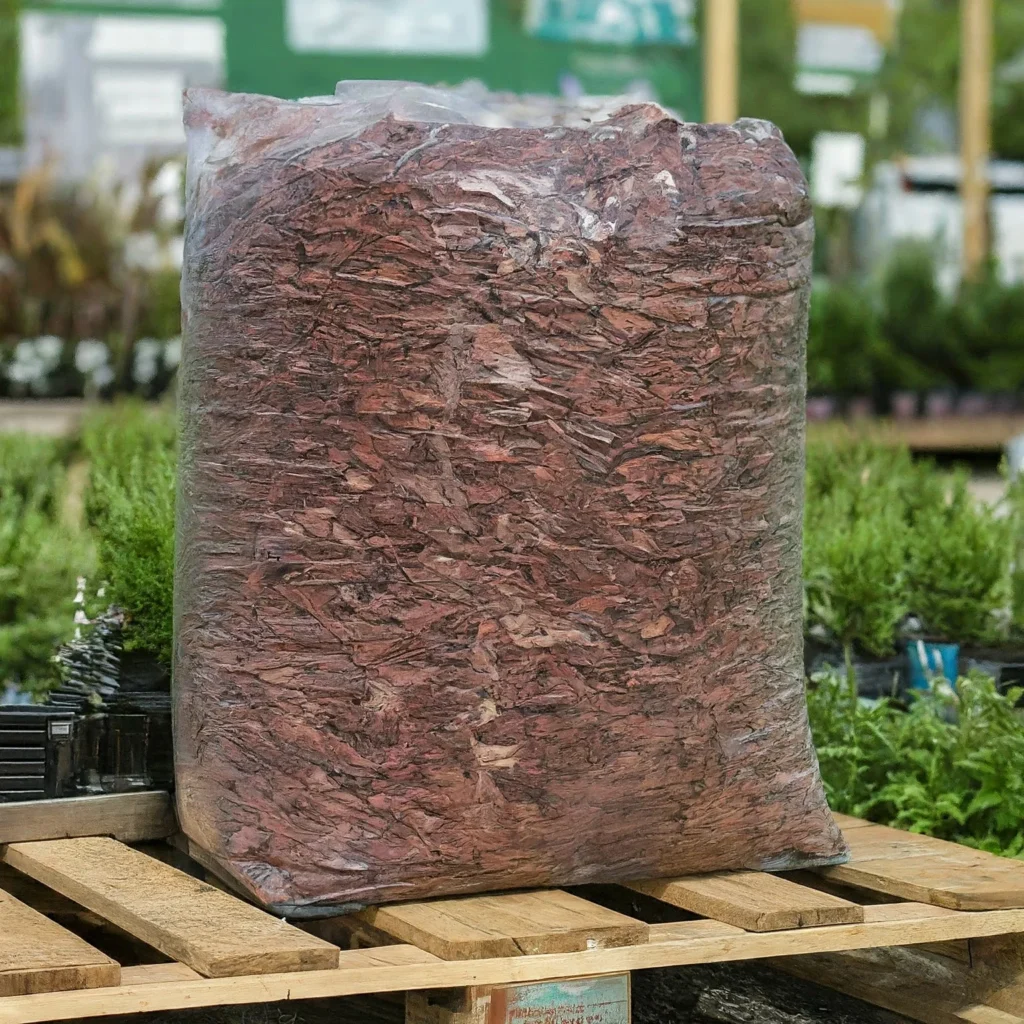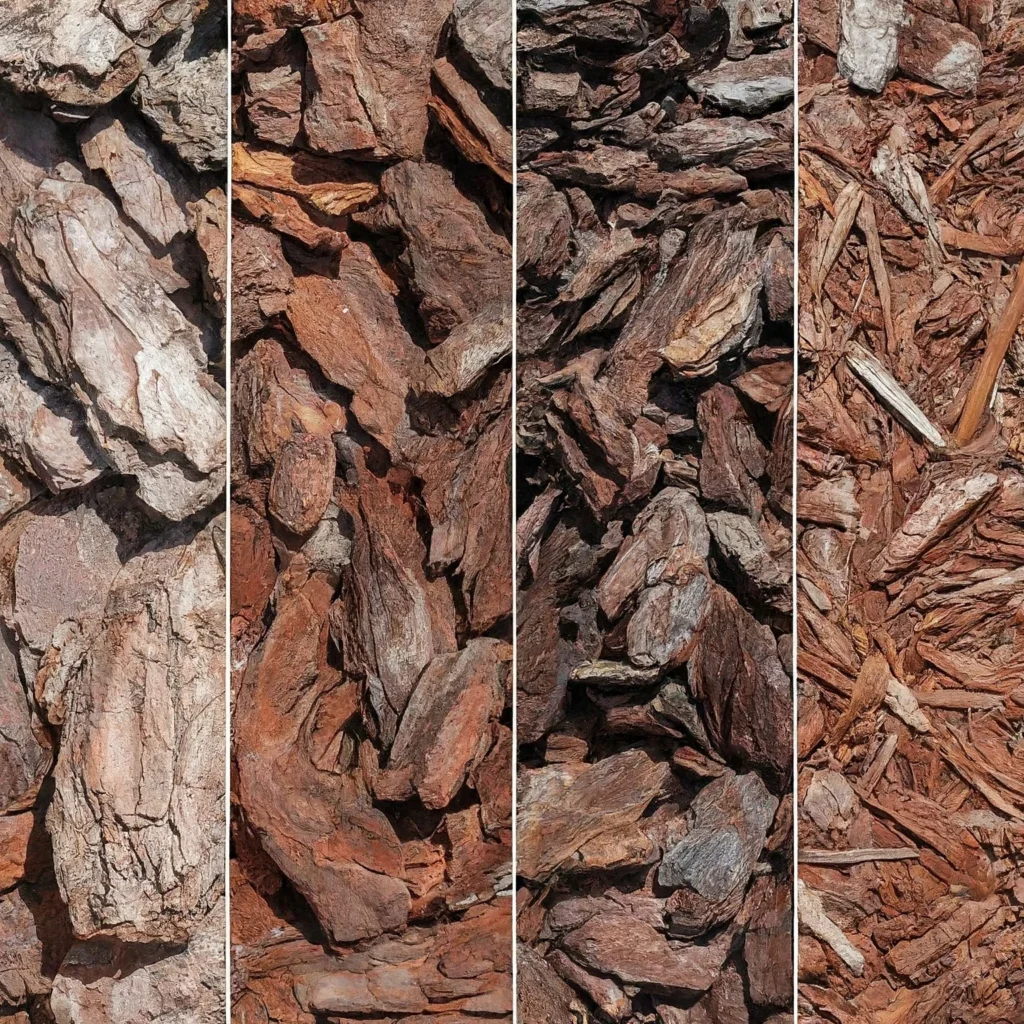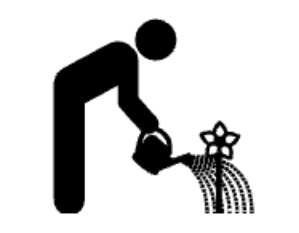If you’ve been gardening for a while or are just starting out, you’ve probably heard about the wonders of mulch. Mulching is great for any garden, offering benefits that go far beyond aesthetics.
But not all mulches are created equal, and today, we’ll discuss one of the most popular and versatile options available—pine bark mulch.
So, what exactly is pine bark mulch, and why should you consider it for your garden?
What is Pine Bark?

Pine bark is exactly what it sounds like—the outer bark of pine trees.
When pine trees are harvested for timber, the bark is stripped off and repurposed, often being processed into mulch. Pine bark is naturally resistant to decay, making it an ideal material for garden use.
Pine bark mulch is a type of organic mulch made from the shredded or chipped bark of pine trees. It’s widely available, environmentally friendly, and packed with benefits for both the gardener and the garden itself.
Whether you want to improve the health of your soil or simply want to give your garden a polished, professional look, pine bark mulch has you covered.
Types of Pine Bark Mulch

Pine bark mulch comes in several forms, each with its own unique characteristics and best-use scenarios. Understanding these types will help you choose the right one for your garden needs.
Let’s take a closer look at the main types of pine bark mulch available:
1. Shredded Pine Bark Mulch
Shredded pine bark mulch is the most common and versatile form of pine bark mulch. It’s made by finely grinding the outer bark of pine trees into small, fibrous pieces.
- Ease of Application: Because it’s finely shredded, this type of mulch is easy to spread evenly across garden beds. It fills in gaps well, providing comprehensive coverage that helps to suppress weeds effectively.
- Quick Decomposition: Shredded pine bark mulch decomposes faster than larger bark pieces. This rapid breakdown quickly adds organic matter to the soil, improving soil structure and fertility.
- Excellent Moisture Retention: The fine texture of shredded mulch allows it to hold moisture well, making it ideal for areas where water conservation is a priority, such as in flower beds or vegetable gardens.
- Best For: Shredded pine bark mulch is ideal for use in perennial beds, flower gardens, and areas where you want to create a smooth, uniform appearance.
2. Coarse Pine Bark Mulch
Coarse pine bark mulch consists of larger, chunkier pieces of pine bark. These pieces are not as finely ground as shredded mulch, which gives them a more rugged appearance and different functional benefits.
- Longer Lifespan: Coarse pine bark mulch breaks down more slowly than shredded mulch. This means it can last for several years without needing to be replenished, making it a low-maintenance option for gardeners.
- Good for Erosion Control: The larger pieces of coarse mulch are heavier and less likely to be blown away by the wind or washed away by rain. This feature makes it an excellent choice for sloped areas or regions prone to erosion.
- Improved Soil Aeration: While coarse mulch doesn’t hold moisture as well as shredded mulch, it excels in improving soil aeration. The larger gaps between the pieces allow air to circulate more freely through the soil, which is beneficial for root health.
- Best For: Coarse pine bark mulch is ideal for use around trees, shrubs, and in areas where you want to maintain a natural, less manicured look. It’s also great for mulching around plants that prefer well-aerated soil.
3. Pine Bark Nuggets
Pine bark nuggets are the largest form of pine bark mulch. These nuggets range in size from small pebbles to large chunks and provide a distinctive look and function:
- Unique Appearance: Pine bark nuggets have a bold, chunky texture that can add a dramatic visual element to your garden. They create a more rustic, natural look compared to finer mulches.
- Slow Decomposition: Like coarse mulch, pine bark nuggets break down very slowly. This slow decomposition makes them a durable mulching option that requires less frequent replacement.
- Good for Heavy Traffic Areas: Thanks to their size and weight, pine bark nuggets are less likely to be displaced by wind or rainfall. This makes them an excellent choice for pathways, playgrounds, or areas with heavy foot traffic.
- Potential Drawbacks: One thing to consider with pine bark nuggets is that they can float and be washed away during heavy rainstorms. Also, because they don’t form a dense layer like shredded mulch, they may allow some weeds to grow through.
- Best For: Pine bark nuggets are best for areas that require robust, long-lasting mulch. Plus, they’re excellent for decorative purposes in landscape beds, around large trees, or along pathways.
4. Double Shredded Pine Bark Mulch
Double-shredded pine bark mulch undergoes an additional grinding process that produces even finer particles compared to regular shredded mulch.
- Superior Coverage: The extra shredding process creates a finer texture, allowing this mulch to spread more evenly and cover the soil more thoroughly. This makes it highly effective at suppressing weeds and retaining moisture.
- Enhanced Aesthetic: Double shredded mulch has a smoother, more uniform appearance, meaning it can give your garden a polished, well-maintained look.
- Faster Decomposition: Because it’s so finely shredded, double-shredded pine bark mulch decomposes more quickly than other types, rapidly adding organic matter to the soil. This is beneficial if you’re looking to improve soil fertility in the short term.
- Best For: Double shredded pine bark mulch is ideal for gardeners who want a neat, refined appearance for their garden beds. It’s particularly well-suited for flower gardens, vegetable patches, and areas where a consistent, even layer of mulch is desired.
5. Premium Pine Bark Mulch
Premium pine bark mulch is often considered the highest quality option available. It is typically made from the finest, most uniform pieces of pine bark.
- High Purity: Premium mulch is usually screened to remove debris, sticks, and large chunks, ensuring a cleaner, more consistent product. This makes it ideal for gardeners who want the best possible mulch for their plants.
- Long-Lasting: Although it’s finely shredded, premium pine bark mulch is made from carefully selected pieces that decompose at a slower rate, providing long-lasting coverage without frequent replacement.
- Rich Color: Premium mulch often has a richer, more vibrant color than standard options. This not only enhances the aesthetic appeal of your garden but also ensures that the mulch retains its color longer without fading.
- Improved Soil Health: Due to its high-quality composition, premium pine bark mulch adds valuable organic matter to the soil as it decomposes, improving soil structure and fertility over time.
- Best For: Premium pine bark mulch is best suited for high-visibility areas of your garden where aesthetics are paramount. It’s also a great choice for use around delicate plants that can benefit from the extra care provided by this superior mulch.
Since each type of mulch offers unique benefits, choosing the right one will depend on your gardening goals, the plants you’re growing, and the overall appearance you desire for your garden.
What are the Benefits of Pine Bark Mulch in Gardening?

Using pine bark mulch in your garden is more than just an aesthetic choice—it’s a practical one too. This versatile mulch offers a range of benefits that go beyond simply covering the soil.
From keeping weeds at bay to improving soil health and conserving moisture, pine bark mulch can play a crucial role in maintaining a thriving garden.
Weed Control
Pine bark mulch acts as a natural weed suppressant. It covers the soil and blocks sunlight, helping prevent weed seeds from germinating.
Moisture Retention
Watering your garden can feel like a never-ending task, especially during the hot summer months. But the good news is that with pine bark mulch, you can conserve more water.
How?
It acts as a barrier, decreasing water evaporation and keeping the soil hydrated for extended periods. This not only helps your plants thrive but also reduces your water bill—a win-win situation!
Soil Temperature Regulation
Pine bark mulch helps regulate soil temperature through insulation.
In the summer, it keeps the soil cooler, and in the winter, it provides warmth, creating a more stable environment for your plants year-round.
Improved Soil Health
As pine bark mulch breaks down, it adds organic matter to your soil. This improves soil structure, making it more friable and easier for roots to penetrate.
Over time, the mulch also releases nutrients, enriching your soil and promoting healthier plant growth.
Aesthetic Appeal
Pine bark mulch gives your garden a clean, uniform appearance that can enhance its overall beauty. Plus, it comes in a rich, natural color that complements any landscape design.
How to Use Pine Bark Mulch Effectively?
Applying pine bark mulch is easy, but there are a few things to keep in mind.
First, remove any weeds from the area where you plan to mulch. Then, distribute the mulch uniformly, creating a protective layer about 2-3 inches thick. Be careful not to pile it up against the stems or trunks of your plants, as this can lead to rot.
The ideal depth for mulching depends on its application.
For flower beds and vegetable gardens, 2-3 inches is usually sufficient.
For pathways or areas with heavy foot traffic, you might want to go a bit deeper, up to 4 inches. This ensures the mulch stays in place and provides adequate protection.
While pine bark mulch is relatively low-maintenance, it does require some upkeep.
Over time, it will decompose and compact, so it’s a good idea to fluff it up occasionally and add a fresh layer once or twice a year. Also, keep an eye out for any signs of mold or fungus, especially in damp, shaded areas.
Compatibility With Plants
Pine bark mulch is generally compatible with most plants, but it’s particularly beneficial for acid-loving plants like azaleas, rhododendrons, and blueberries.
However, if you’re growing plants that prefer alkaline soil, you might want to consider a different type of mulch, as pine bark can slightly lower the soil’s pH over time.
Vegetable Gardens
Using pine bark in your vegetable garden can help retain moisture, suppress weeds, and improve soil structure. Just be sure to keep the mulch away from the base of your plants to prevent rot.
Flower Beds
Flower beds are where pine bark mulch truly shines. It not only helps your flowers thrive by maintaining moisture and reducing weeds but also adds a polished look to your garden.
Tree and Shrub Circles
Mulching around trees and shrubs helps protect their root systems and conserves moisture. Just be careful not to create a “mulch volcano” around the trunk—keep the mulch spread out evenly.
Container Gardening
If you’re into container gardening, this mulch can be a great addition to your pots. It helps retain moisture in the soil and adds a decorative touch to your containers.
Pathways and Driveways
Mulch made from pine bark is also ideal for creating natural pathways and driveways. It provides a soft, cushioned surface that’s easy on the feet and helps reduce erosion.
Environmental Considerations of Pine Bark Mulch
Pine bark mulch is an environmentally friendly option because it’s a byproduct of the timber industry. Instead of letting the bark go to waste, it’s repurposed into mulch, reducing the need for synthetic alternatives.
Impact on Soil pH: Potential Effects on Soil Acidity
While this mulch type can slightly lower the soil’s pH over time, this isn’t usually a cause for concern unless you’re growing plants that require a very specific pH range.
In most cases, the benefits of using pine bark mulch far outweigh any potential downsides.
Troubleshooting and Tips
Like any mulch, pine bark mulch can sometimes develop mold, especially in damp conditions.
To prevent this, make sure your garden is well-drained, and consider turning the mulch occasionally to improve air circulation.
Pests are generally not a major issue with this type of mulch, but if you do notice any unwanted visitors, a sprinkle of diatomaceous earth can help keep them at bay.
Alternatives to Pine Bark Mulch
While pine bark is an excellent mulch, it’s not the only option out there. If you’re looking for alternatives, consider straw, wood chips, or compost.
Each type of mulch has its own set of benefits, so it’s worth experimenting to find what works best for your garden.
As compared to other mulches, the longevity, aesthetic appeal, and soil-enhancing properties of pine bark stand out. While other mulches may decompose faster or offer different benefits, this one remains a top choice for many gardeners due to its versatility and effectiveness.
How Often Should You Replace Pine Bark Mulch?
You should replace pine bark mulch once a year or as needed.
Over time, it will break down and become compacted, reducing its effectiveness. Adding a fresh layer each year will keep your garden looking its best.
Using Pine Bark Mulch for Orchids and Succulents
Pine bark mulch is an excellent choice for orchids, as it provides good drainage and air circulation. For succulents, use a thin layer of mulch to help retain moisture without causing rot.
Conclusion
To wrap things up, pine bark mulch is a fantastic addition to any garden. It offers a wide range of benefits, from improving soil health to enhancing the appearance of your landscape.
Whether you’re mulching flower beds, vegetable gardens, or even pathways, pine bark is a versatile, effective, and environmentally friendly choice.

